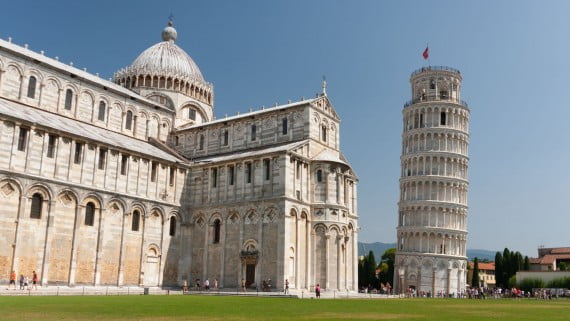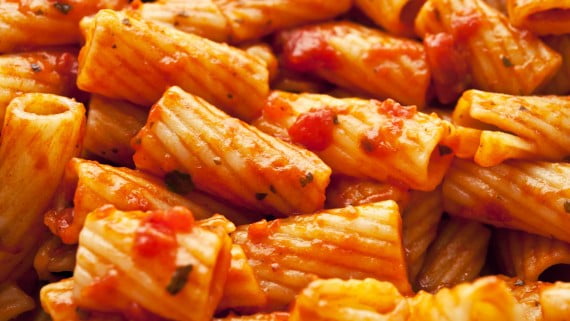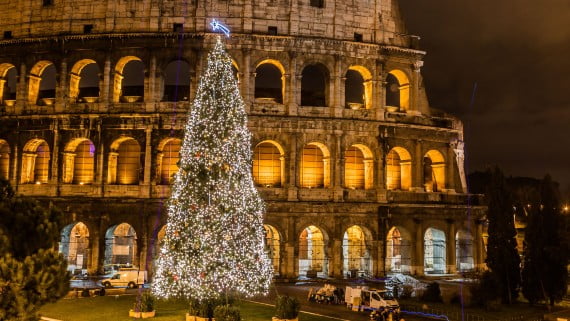Today's Italy is one of the countries that arouses the most curiosity about its culture and customs. In addition, Italian immigrants who arrived in countries such as Argentina, Peru, Chile, Uruguay, Venezuela and Mexico contributed to the expansion of this culture in the world. In this article we show you a list of the most important folk customs, as well as some of the rarest.
Below you have an index with all the points that we are going to deal with in this article.
Article Index
- 1.
- 2.
- 3.
- 4.
- 5.
- 6.
- 7.
- 8.
- 9.
- 10.
- 11.
- 12.
Architecture
The architecture of Italy refers to the wide range of architectural styles that the Italian landscape enjoys, which are not only classified by period but also by region.
Italy has always stood out in this field for its extensive technical advances, which could already be observed in the past through the construction of domes, arches and the recreation of structures similar to those of the Roman empireAn example of this being the famous Tower of Pisa.
Italy has several monumental works representative of Western architecture, among them the Roman Coliseum, Florence Cathedral, Milan Cathedral, Saint Peter's Basilica and a long etcetera.
The importance of Italian architecture is such that the use of the expression has spread Italianate architecture o Italian and this is something Italians are enormously proud of.
Art
The passion for Fine Arts in Italy is well known and is one of its oldest customs. Already in the Roma Ancient was Hellenistic art, of which several copies have survived to this day.
The typical paintings of this era showed landscapes, caricatures, portraits, life and customs, architectural imitations, etc. In short, this artistic custom reached the Renacimiento, time in which it received the name of grotesque.
Renaissance painting brought with it the evolution of the sculptural art, which reached its maximum splendor from the XNUMXth century to the XNUMXth and XNUMXth centuries. For its part, the passion for sculpture is also inherited from Antigua Roma.
The typical Italian sculptures were preferably made of marble, although there are also bronze and ivory sculptures, although most of those that are preserved today are deteriorated. The typical motifs of Italian sculptures are nature and the adoption of classical forms and uses of Greece and Rome.
Weddings
As in Spain and other countries in which the Catholic religion predominates, in Italy marriage is an event, something like a symbol of what each one wants in life and an indicator of social status. Although the most traditional form of celebration occurs in southern Italy, as a general rule, marriage is divided into two phases: before and after.
Thus, before the actual wedding takes place The promise or, what is the same, the pre-marriage celebration, which happens weeks before the party.
In this phase, the parish priest formulates a series of questions to the bride and groom in the church where they will later have the marriage. To end this day, it is customary to have a dinner in style with the family and friends of the couple (usually about 80-100 people).
In the two or three days prior to the wedding, easy letto, that is, the bed is made. This means that the family and friends of the future couple meet at their home and decorate the couple's room in order to make it ready for the wedding night. This decoration includes flowers, chocolates, sweets, champagne bottles and, above all, money.
This custom of celebrating the marriage union surrounded by crowds of people can be observed already during the courtship, which, unlike in other countries in the world, is a group stage.
On the wedding day itself, the first step is to meet at the bride and groom's house to greet and congratulate both the bride and groom and their closest relatives. Once this is done, the custom is for the guests to go after the bride's car on the way to church.
In the ecclesiastical ceremony, the bride arrives hand in hand with the father and on the way out, rice is thrown at the newlyweds just like in Spanish weddings. The final banquet is a feast that lasts for hours and in which the objective is clear: to eat without stopping.
Café
If before we mentioned that pasta and pizza are two of the main Italian icons, coffee deserves a special mention. Many are those who affirm that, in Italy, coffee is "in their blood" and that this country saw the birth of popular types of coffee such as espresso, macchiato, capuccino, the ristretto ... For Italians, coffee is a social act, that is, a means by which to interact with others.
There is a wide range of types of coffee in Italy, all of them suitable for any palate. However, they all have two characteristics in common that make them so special: on the one hand, the grain quality and, on the other hand, the art of the Italians to prepare it.
There are roughly two ways to prepare coffee. One of them is espresso, which consists of using the pressure of water vapor, which produces a sparkling and more intense result than filtered coffee. The second way is the one used for cappuccino, for which milk is used to steam it.
Venice's Carnival
When it comes to mentioning the most typical parties and festivals in Italy, without a doubt the first that comes to mind is the Carnival of Venice or, in other words, the Italian carnival par excellence.
This massive festival has its origin in the year 1296, when it was celebrated as a public festival per se for the first time. Carnival begins 12 days before Lent and ends on Shrove Tuesday.
The custom during this festival is to dress up, but not just any costume will do: Venice carnival costumes follow a series of patterns, the most basic of which is to wear a mask.
In reality, these distinctive costumes represent characters from the Comedy of Art (Commedia dell'Arte in Italian) of the XNUMXth century, which was the theater of the people, that is, of the lower class.
Costumes were traditionally intended ridicule to the characters mentioned above, so the most typical costumes are those of:
- Harlequin
- Pantalone
- Punchinel
- Colombina
- Pierrot
- Brighella
All of them claim to represent arrogant, ambitious, rich, greedy, romantic characters, etc. The mask, for its part, is called nobile maschera and consists of a white mask, a three-pointed hat and black silk clothing.
Family
For Italians, the role of the family is very important and this can be observed in the strong ties of union that exist between parents and children. L
he vast majority of Italian families respond to the “old-fashioned” family prototype, that is, each member of the family unit responds to a specific role and the respect it is given by the role that has been assigned to each one.
This is reflected from the courtship through marriage as we will talk later, and in other contexts, usually related to religion, such as bautismo, communion or confirmation, Italian customs related to children.
For example, the importance of the christening is such that the party that takes place before and after is similar to the one that is prepared for the wedding day, that is, of a massive nature.
Gastronomy
La Italian gastronomy It constitutes one of the most typical icons of the customs and customs of Italy, as well as a reflection of the cultural diversity existing in this European country.
Its typical dishes are included within the famous Mediterranean diet and its preparation requires a series of culinary customs of the most characteristic.
Without a doubt, the first dish that comes to mind when you think of typical food of Italy is pizza, a dish that has been around the world and of which there are endless varieties.
Of course, after pizza the next quintessential dish is pasta with its infinite versions, ingredients and accessories. Italian pasta is open to the imagination of those who cook it, although it has been some specific recipes that have triumphed over time.
Normally, pasta is always accompanied by a sauce and various spices such as oregano or basil. Pasta dishes as well as pizza are served as a first course or the first, after l'antipasto or starter if the typical structure of the Italian menu is followed.
Among the most typical pasta we highlight the following:
- Cannelloni
- Ravioli
- Tagliatelle
- Spaghetti
- Maccheroni
It is worth mentioning that Italians not only have a passion for their gastronomy, but they also have a series of fundamental customs when it comes to sitting. in the table and when eating.
Although there are several habits, the basic rules are two: first, cutting pasta with a knife is considered an act of very rudeness; secondly, it is quite frowned upon to accompany a pasta dish with bread.
Music
Italians have two typical musical genres: the Opera and instrumental music. However, these styles vary according to each region of the country, where popular and romantic music is also included.
In short, music, like food and other aspects, has been the most representative symbol of Italian cultural identity since the late XNUMXth century, when European classical music and opera began to develop.
Opera, a word from the Italian language and what it means musical work, dates back to 1800 and immediately obtained a very good reception among the national people.
Italians today continue to be very proud of their musical genre par excellence, especially in reference to lyrical singing thanks to figures like the late Luciano Pavarotti.
Christmas
Of all the European countries, Italy is one of the ones that offers the most variety in terms of traditions at this time. At first glance, the tourist can see that the streets are not illuminated or decorated as much as in other countries.
Continuing with the custom of being very family, Italians have a saying for Christmas: Natale with i tuoi, Easter with chi vuoi, Meaning Christmas with yours, Easter with whoever you want. In this way, it can be seen that most of the Christmas celebrations take place at home, together with those closest to them.
On December 24, the Christmas Eve With the traditional dinner, which literally means great dinner. It begins with antipasti or starters, which are followed by spaghetti with clams, fish, vegetables, fruit, nougat, etc.
The 25th day of Christmas is celebrated with big meals, visits to relatives, meetings with friends and gift exchanges.
En New Years Eve , the dinner that is prepared is known as the New Year's night, in which, once again, you eat and drink in abundance. When twelve o'clock at night arrives, it is customary to go out to the balconies to say goodbye to the year that is leaving and to welcome the new year.
In some regions of Italy, at this time, red garments are given among the members of the dinner as a symbol of good luck for the coming year, while in Naples, Sicily and Calabria an ancient custom is maintained that consists of throwing furniture and disused utensils by the window, as a symbol of the detachment of all the bad that could have happened the previous year.
Easter and Easter
Like Christmas, Easter also represents a special date on the Italian calendar. Holy Week is celebrated in a similar way to Spain through ancient processions and rituals that run through the streets of towns and cities and in which you can see devotees of all age ranges.
Italian processions correspond to the funeral beliefs and values of Italy in the sense that they represent a very sentimental act.
The most outstanding processions take place first in the Vatican City with the mass led by the pope in St. Peter's Basilica by candlelight. Secondly, the celebrations that take place in Rome also stand out.
In Sardinia, for example, the Cagliari fellowships organize a series of processions that have become the most popular in Italy, beginning on Palm Sunday.
In Florence, Easter Sunday is synonymous with peace and forgiveness. For this reason, on that day the Plaza del Duomo, one of the main arteries of the city, is filled with fireworks and the show known as wagon burst, Meaning car explosion.
El egg it also has a most curious meaning during Italian Easter. It is a symbol of the beginning of life and is used even in children's games such as the famous tip and cul, which is widely practiced in the province of Pesaro, in Umbria. Likewise, there are several typical dishes of Italian Easter that incorporate the egg in their recipe.
Religiosity
According to an investigation by Eurispes, an Italian entity dedicated to the study of different political, economic and social values, more than 87% of the population Italian declares themselves Catholic and almost 40% practicing.
Of those surveyed in the previous research, 30,8% of people between 18 and 24 years old attend mass every Sunday, while only 28,5% of subjects between 34 and 44 years old do so every Sunday. Thus, with these figures we can get an idea of the importance of religion for Italian society, where age is not a determining factor.
Considering these figures, it is no coincidence that the Vatican, where the Santa Thirst (highest institution of the Catholic Church), is in Italy.
Therefore, events such as marriage, baptism, communion and the celebration of religious holidays such as the day of Saint Francis of Assisi, among many others, reflect the meaning of the Italian faith.
regards
Among the most characteristic social customs of the Italian community, the way they greet each other is striking.
The most common greeting is to shake hands and then give A kiss in the cheek of the other person without touching it with the lips.
This greeting is similar to the Spanish custom of giving two kisses on the cheeks, with the difference that the Spanish offer the right cheek first and the Italians the left.
However, it is known thanks to several comparative studies that Italians do not feel too comfortable when they make this greeting with a Spaniard because, according to them, the latter shows too much effusiveness when doing it.
The most informal form of greeting is the popular Hello, which is used so much to say Hello as goodbye.
On the other hand, in contexts that require a bit more formality, the most used formulas are good morning y good evening to say good morning y good afternoonrespectively.
For its part, our Goodnight equivalent to good night and it is used only when the person in question is literally going to sleep. At the regional level there is a very widespread form that is buondi ' and it means the same as good morning, except that it is used at any time of the day.
On the other hand, when it comes to greeting strangers or addressing a group, the usual is to say Hello.
This article has been shared 538 times. We have spent many hours collecting this information. If you liked it, share it, please:

















































